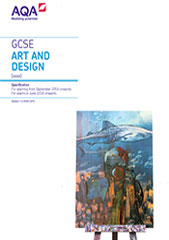3.5 Fine art
Fine art practice is defined here as the need to explore an idea, convey an experience or respond to a theme or issue of personal significance.
Areas of study
In Component 1 and Component 2 students are required to work in one or more area(s) of fine art, such as those listed below:
- drawing
- painting
- sculpture
- installation
- lens-/light-based media
- photography and the moving image
- printmaking
- mixed media
- land art.
They may explore overlapping areas and combinations of areas.
Knowledge, understanding and skills
Students must develop and apply the knowledge, understanding and skills specified in the Subject content within the context of fine art practice and their selected area(s) of study.
The following aspects of the knowledge, understanding and skills are defined in further detail to ensure students’ work is clearly focused and relevant to fine art.
Knowledge and understanding
The way sources inspire the development of ideas, relevant to fine art including:
- how sources relate to individual, social, historical, environmental, cultural, ethical and/or issues-based contexts
- how ideas, themes, forms, feelings and concerns can inspire personally determined responses that are primarily aesthetic, intellectual or conceptual.
The ways in which meanings, ideas and intentions relevant to fine art can be communicated including the use of:
- figurative representation, abstraction, stylisation, simplification, expression, exaggeration and imaginative interpretation
- visual and tactile elements, such as:
- colour
- line
- form
- tone
- texture
- shape
- composition
- rhythm
- scale
- structure
- surface.
Skills
Within the context of fine art, students must demonstrate the ability to:
- use fine art techniques and processes, appropriate to students’ personal
intentions, for example:
- mark-making
- monoprint, collagraph and block printing
- assemblage
- construction
- carving
- film and video
- digital working methods
- use media and materials, as appropriate to students’ personal intentions, for
example:
- charcoal, pastels, pen and ink, crayons and pencil
- watercolour, gouache, acrylic and oil paint
- found materials
- clay, wood and metal
- digital imagery
- different papers and surfaces on which to work.
